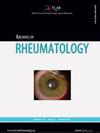The relationship between clinical parameters and ultrasonographic enthesitis assessment in patients with spondyloarthritis
IF 1.1
4区 医学
Q4 Medicine
引用次数: 0
Abstract
Objectives: The study aimed to evaluate the role of ultrasonographic assessment of enthesitis in patients with spondyloarthritis (SpA) in terms of disease activity, functionality, and quality of life. Patients and methods: Ninety SpA patients (57 males, 33 females; mean age: 37.5±9.7 years; range, 18 to 60 years) were included in cross-sectional study between November 2016 and January 2017. Bath Ankylosing Spondylitis Disease Activity Index (BASDAI), Ankylosing Spondylitis Disease Activity Score (ASDAS), Bath Ankylosing Spondylitis Functional Index (BASFI), Short Form-12 (SF-12), and Ankylosing Spondylitis Quality of Life (ASQoL) were utilized for clinical evaluation. The clinical evaluation of enthesitis was performed with the Spondyloarthritis Research Consortium of Canada (SPARCC) and Maastricht Ankylosing Spondylitis Enthesitis Score (MASES) via an algometer calibrated to 4 kg/cm2 of pressure. Ultrasound evaluation was performed according to Madrid Sonographic Enthesitis Index (MASEI). A total of 2,610 entheseal sites were examined clinically, and 1,080 were assessed ultrasonographically. Results: A significant proportion of enthesitis (463/1,080) was detected on ultrasonographic evaluation but not with clinical enthesitis score (MASES and SPARCC). Although ultrasonographic entheseal evaluation detected enthesitis in at least one enthesis of all patients, 35 of the patients had no enthesitis with clinical examination. The sites most frequently involved in the entheses were the proximal patellar tendon and Achilles tendon. The MASEI score did not correlate with the MASES, SPARCC, BASDAI, SF-12, and ASQoL but moderately correlated with the C-reactive protein (CRP) level (r=0.348), ASDAS-CRP (r=0.294), and BASFI score (r=0.244). Conclusion: The association of ultrasonography scores with CRP levels and ASDAS-CRP indicates that ultrasonography is effective in detecting inflammation. The MASEI score weakly correlates with functionality but not with quality of life. Ultrasonographic evaluation is invaluable and merits to be incorporated into SpA disease scoring system.脊柱关节炎患者临床参数与超声波夹缝炎评估之间的关系
研究目的本研究旨在评估脊柱关节炎(SpA)患者的关节内膜炎超声评估在疾病活动度、功能和生活质量方面的作用。患者和方法在2016年11月至2017年1月期间,纳入90名SpA患者(57名男性,33名女性;平均年龄:37.5±9.7岁;范围:18至60岁)进行横断面研究。临床评估采用巴斯强直性脊柱炎疾病活动指数(BASDAI)、强直性脊柱炎疾病活动评分(ASDAS)、巴斯强直性脊柱炎功能指数(BASFI)、短表格-12(SF-12)和强直性脊柱炎生活质量(ASQoL)。夹腱炎的临床评估采用加拿大脊柱关节炎研究联合会(SPARCC)和马斯特里赫特强直性脊柱炎夹腱炎评分(MASES),通过校准为 4 kg/cm2 压力的算法进行。超声波评估根据马德里超声波切口炎指数(MASEI)进行。共对 2,610 个内眦部位进行了临床检查,对 1,080 个内眦部位进行了超声波评估。结果显示超声波评估发现了相当比例的内趾关节炎(463/1,080),但临床内趾关节炎评分(MASES 和 SPARCC)却未发现。虽然所有患者中至少有一名患者在超声波内固定评估中发现了内固定炎,但其中 35 名患者在临床检查中没有发现内固定炎。粘连最常累及的部位是髌腱近端和跟腱。MASEI 评分与 MASES、SPARCC、BASDAI、SF-12 和 ASQoL 没有相关性,但与 C 反应蛋白(CRP)水平(r=0.348)、ASDAS-CRP(r=0.294)和 BASFI 评分(r=0.244)有中度相关性。结论超声波检查评分与 CRP 水平和 ASDAS-CRP 的相关性表明,超声波检查能有效检测炎症。MASEI 评分与功能的相关性较弱,但与生活质量无关。超声波评估非常有价值,值得纳入SpA疾病评分系统。
本文章由计算机程序翻译,如有差异,请以英文原文为准。
求助全文
约1分钟内获得全文
求助全文
来源期刊

Archives of rheumatology
Medicine-Rheumatology
CiteScore
2.00
自引率
9.10%
发文量
15
期刊介绍:
The Archives of Rheumatology is an official journal of the Turkish League Against Rheumatism (TLAR) and is published quarterly in March, June, September, and December. It publishes original work on all aspects of rheumatology and disorders of the musculoskeletal system. The priority of the Archives of Rheumatology is to publish high-quality original research articles, especially in inflammatory rheumatic disorders. In addition to research articles, brief reports, reviews, editorials, letters to the editor can also be published. It is an independent peer-reviewed international journal printed in English. Manuscripts are refereed by a "double-blind peer-reviewed" process for both referees and authors.
Editorial Board of the Archives of Rheumatology works under the principles of The World Association of Medical Editors (WAME), the International Council of Medical Journal Editors (ICMJE), and Committee on Publication Ethics (COPE).
 求助内容:
求助内容: 应助结果提醒方式:
应助结果提醒方式:


